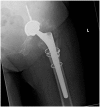Extended trochanteric osteotomy: improving the access and reducing the risk in revision THA
- PMID: 32175097
- PMCID: PMC7047899
- DOI: 10.1302/2058-5241.5.190005
Extended trochanteric osteotomy: improving the access and reducing the risk in revision THA
Abstract
This review article presents a comprehensive literature review regarding extended trochanteric osteotomy (ETO).The history, rationale, biomechanical considerations as well as indications are discussed.The outcomes and complications as reported in the literature are presented, discussed and compared with our own practice.Based on the available evidence, we present our preferred technique for performing ETO, its fixation, as well as post-operative rehabilitation.The ETO aids implant removal and enhanced access. Reported union rate of ETO is high. The complications related to ETO are much less frequent than in cases when accidental intra-operative femoral fracture occurred that required fixation.Based on the literature and our own experience we recommend ETO as a useful adjunct in the arsenal of the revision hip specialist. Cite this article: EFORT Open Rev 2020;5:104-112. DOI: 10.1302/2058-5241.5.190005.
Keywords: ETO; extended trochanteric osteotomy; revision hip arthroplasty; revision hip replacement; union rate of ETO.
© 2020 The author(s).
Conflict of interest statement
ICMJE Conflict of interest statement: EP reports employment by the HDU Health Board outside the submitted work. PHJC reports employment by the Hywel Dda University Health Board outside the submitted work. The other authors declare no conflict of interest relevant to this work.
Figures



Similar articles
-
Extended Trochanteric Osteotomy in Revision Total Hip Arthroplasty.JBJS Essent Surg Tech. 2023 Jul 21;13(3):e21.00003. doi: 10.2106/JBJS.ST.21.00003. eCollection 2023 Jul-Sep. JBJS Essent Surg Tech. 2023. PMID: 38282724 Free PMC article.
-
Outcomes and Risk Factors of Extended Trochanteric Osteotomy in Aseptic Revision Total Hip Arthroplasty: A Systematic Review.J Arthroplasty. 2020 Nov;35(11):3410-3416. doi: 10.1016/j.arth.2020.07.034. Epub 2020 Jul 22. J Arthroplasty. 2020. PMID: 32800436
-
Trochanteric osteotomy in revision total hip arthroplasty.EFORT Open Rev. 2020 Sep 10;5(8):477-485. doi: 10.1302/2058-5241.5.190063. eCollection 2020 Aug. EFORT Open Rev. 2020. PMID: 32953133 Free PMC article. Review.
-
Extended trochanteric osteotomy in revision hip arthroplasty: a case series study and systematic literature review.Arthroplasty. 2022 Apr 3;4(1):14. doi: 10.1186/s42836-022-00115-w. Arthroplasty. 2022. PMID: 35366949 Free PMC article.
-
Extended trochanteric osteotomy: current concepts review.Eur J Orthop Surg Traumatol. 2016 Apr;26(3):231-45. doi: 10.1007/s00590-016-1749-z. Epub 2016 Feb 29. Eur J Orthop Surg Traumatol. 2016. PMID: 26923564 Review.
Cited by
-
[Tips and tricks of cement removal in the case of revision surgery].Orthopadie (Heidelb). 2024 Mar;53(3):176-184. doi: 10.1007/s00132-023-04453-8. Epub 2023 Oct 19. Orthopadie (Heidelb). 2024. PMID: 37855912 Free PMC article. Review. German.
-
Commercially manufactured spacers for the treatment of periprosthetic joint infection of the hip.Oper Orthop Traumatol. 2023 Jun;35(3-4):179-187. doi: 10.1007/s00064-023-00802-0. Epub 2023 Apr 11. Oper Orthop Traumatol. 2023. PMID: 37041387 Review. English.
-
The influence of hip revision stem spline design on the torsional stability in the presence of major proximal bone defects.PLoS One. 2023 Sep 14;18(9):e0291599. doi: 10.1371/journal.pone.0291599. eCollection 2023. PLoS One. 2023. PMID: 37708193 Free PMC article.
-
Extended trochanteric osteotomy (ETO) and fluted tapered modular stems in revision hip arthroplasty. Does ETO integrity or consolidation, really matter?J Orthop. 2021 Feb 9;23:250-255. doi: 10.1016/j.jor.2021.02.001. eCollection 2021 Jan-Feb. J Orthop. 2021. PMID: 33664557 Free PMC article.
-
Aseptic Revision of Total Hip Arthroplasty With a Single Modular Femoral Stem and a Modified Extended Trochanteric Osteotomy-Treatment Assessment With the Forgotten Joint Score-12.Arthroplast Today. 2022 May 18;15:159-166. doi: 10.1016/j.artd.2022.03.024. eCollection 2022 Jun. Arthroplast Today. 2022. PMID: 35601994 Free PMC article.
References
-
- Learmonth ID, Young C, Rorabeck C. The operation of the century: total hip replacement. Lancet 2007;370:1508–1519. - PubMed
-
- Pabinger C, Lothaller H, Portner N, Geissler A. Projections of hip arthroplasty in OECD countries up to 2050. Hip Int 2018;28:498–506. - PubMed
-
- Kurtz S, Ong K, Lau E, Mowat F, Halpern M. Projections of primary and revision hip and knee arthroplasty in the United States from 2005 to 2030. J Bone Joint Surg Am 2007;89:780–785. - PubMed
-
- Mont MA, Issa K. Updated projections of total joint arthroplasty demands in America. Commentary on an article by Steven M. Kurtz, PhD, et al.: ‘Impact of the economic downturn on total joint replacement demand in the United States. Updated projections to 2021’. J Bone Joint Surg Am 2014;96:e68. - PubMed
-
- Patel A, Pavlou G, Mujica-Mota R, Toms A. The epidemiology of revision total knee and hip arthroplasty in England and Wales: a comparative analysis with projections for the United States. A study using the National Joint Registry dataset. Bone Joint J 2015;97-B:1076–1081. - PubMed
Publication types
LinkOut - more resources
Full Text Sources

